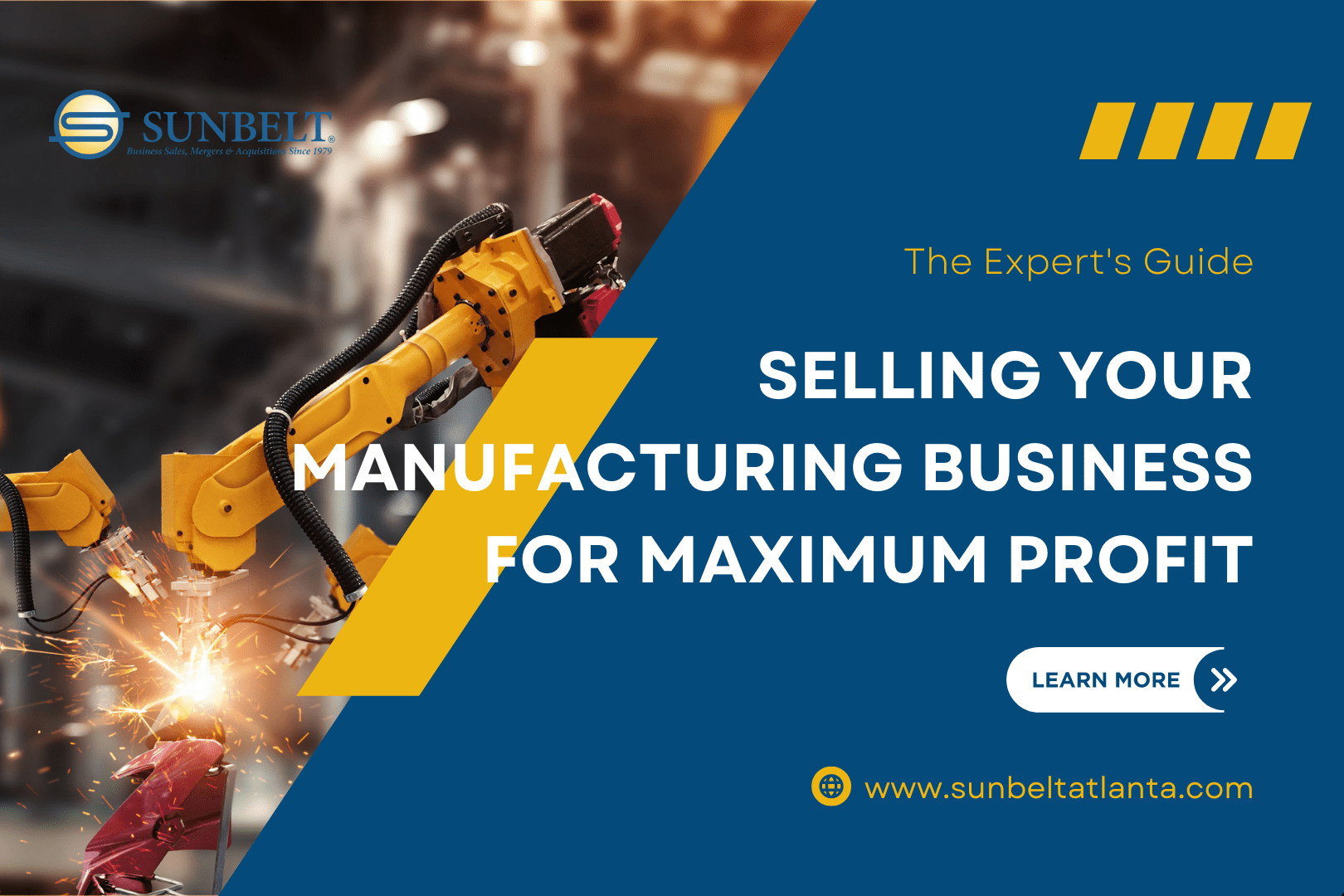10 min read
How to Sell Your Roofing Business in 2025: Tips to Maximize Value
How to Sell a Roofing Company: An Updated Guide for 2025 Selling a roofing company can be a complex process, but it can also be highly rewarding if...
Discover the true value of your business in just a few minutes. Start your confidential valuation today.
%20copy%202.png?width=500&height=208&name=group_jan_30_25_4000px%20(1)%20copy%202.png)
At Sunbelt Atlanta our team is made up of seasoned professionals with more than 90 years of collective experience selling companies. Our backgrounds and industry experience are as varied as the companies we represent. Some come from main-street, some from Wall Street. Collectively, we have closed hundreds of transactions and the companies we have sold range in size from $100,000 to $50,000,000 in revenue and span all industries.
6 min read
 Doreen Morgan
:
Nov 17, 2025 6:59:59 AM
Doreen Morgan
:
Nov 17, 2025 6:59:59 AM
As a business owner, you are likely focused on your P&L, balance sheet, and physical assets. But one of the most critical components of your business's value doesn't appear in a financial statement: your people. As business brokers, we’ve seen countless deals where a company's valuation was significantly impacted—positively and negatively—by its workforce stability. Potential buyers don't just acquire a product or service; they acquire a system, and a stable, experienced team is the engine that runs that system. Investing in employee retention is not just an HR concern; it is a core financial strategy that directly influences your business sale price and success.
High employee turnover is not just a management headache; it's a direct and recurring financial bleed. When a potential buyer conducts due diligence, they will scrutinize these costs. High turnover represents a clear, immediate, and unnecessary drag on profitability that the new owner will have to inherit and solve.
Every time an employee leaves, a costly replacement cycle begins. These direct costs include advertising the open position, management hours spent screening and interviewing candidates, and potential recruitment agency fees. Once you hire a new employee, you face a new set of costs for onboarding, training materials, and the supervisor's time—all before that new hire reaches full productivity. Research from organizations like SHRM (Society for Human Resource Management) frequently estimates that the cost to replace an employee can be as high as six to nine months of their salary.
The financial impact of high turnover goes far beyond recruitment budgets. A "productivity gap" opens the moment an employee decides to leave, as their engagement often drops. This gap widens as the role sits vacant and continues for the months it takes a new hire to get up to speed. Furthermore, high turnover damages the morale of your remaining team members. They are often forced to pick up the slack, leading to burnout, a negative work environment, and, in a vicious cycle, even more departures.
Your experienced employees hold deep institutional knowledge and, critically, your strongest relationships with customers. When a key team member leaves, those client relationships are immediately put at risk. A potential buyer sees this as a major instability. They understand that they aren't just buying your service; they are buying your recurring revenue stream, which is now less secure. This loss of critical client-facing talent can directly reduce the overall value of your business.
When a business broker, private equity group, or strategic buyer performs due diligence, they look for indicators of health and risk. A high employee retention rate is a powerful, positive signal of a healthy, low-risk business. It tells them the company's "secret sauce" isn't just a patent or a product but a well-run process and an experienced team that can execute it.
A stable workforce is a guarantee of business continuity. Buyers are acquiring a future stream of income, and a team that stays ensures that income stream is protected from disruption. They see lower risk because there is no immediate threat of key employees leaving and taking critical knowledge or client lists with them. This stability is especially crucial during the post-sale transition, as it minimizes disruptions and allows for a smoother handover.
High employee retention does not happen by accident. It signals to a buyer that the business has strong management, efficient operational processes, and a positive company culture. This is incredibly valuable. It means the buyer isn't acquiring a "fixer-upper" culture that requires a complete overhaul. They can be confident that the existing team is engaged and will likely continue to perform well, allowing the new owner to focus on growth rather than internal firefighting.
Your company's most valuable assets often walk out the door every night. This "institutional knowledge" includes your unique internal processes, undocumented client histories, and efficient problem-solving shortcuts developed over years. A high retention rate means this intellectual capital is secure and embedded in the business. A buyer is willing to pay a premium for a business that has protected this knowledge, as it is nearly impossible to replace.
Let's look at a practical example we often see in the field. Consider two similarly sized Atlanta-based tech companies, both operating in the B2B SaaS space. On paper, their financials were nearly identical—each hovering around $12M in annual recurring revenue. However, their final valuations came in millions of dollars apart, and the key differentiator was employee retention.
Company A had a 38% annual employee turnover rate, concentrated in its vital software development and sales teams. The buyer's due diligence team immediately flagged this as a major red flag. They calculated that direct recruitment costs and lost productivity from the "productivity gap" were draining over $600,000 annually from the bottom line. More importantly, they saw a business that couldn't protect its talent or its customer relationships, leading to a much lower valuation multiple.
Company B, by contrast, boasted an employee turnover rate of just 6%. Its key developers and top sales executives had been with the company for an average of eight years. The buyer saw a secure, efficient, and well-managed operation. They knew the institutional knowledge was deep, the client relationships were stable, and the team could reliably execute the future growth plan. This demonstrated stability and reduced risk justified a significantly higher multiple, resulting in a final sale price that was 28% higher than Company A's.
Investing in employee retention is a core financial strategy, especially for a business owner preparing for a future sale. You can directly increase your company’s final sale price by proactively fostering a positive work environment. This process should begin years before you plan to list your business, as it takes time to build a stable culture and a track record of retention.
Top talent leaves for two primary reasons: they feel underpaid, or they see no future. Conduct annual market-rate salary reviews to ensure your compensation is competitive for your industry and region. Even more important, create clear, documented paths for development opportunities. When team members can see a tangible future with your company, they are far less likely to seek opportunities elsewhere.
A paycheck is not the only reason employees stay. A strong company culture that fosters a sense of belonging and provides consistent employee recognition is crucial. This can range from simple, public acknowledgment of good work in a team meeting to a more structured employee-of-the-month or performance bonus program. A Gallup analysis confirms that a primary driver of employee engagement and retention is feeling cared for and valued at work.
The first 90 days of employment are critical for long-term retention. A new hire who has a confusing or isolating onboarding experience is significantly more likely to leave within the first year. Implement a structured onboarding process that clearly defines a new employee's role, goals, and path to success. Pairing new hires with experienced team members in a formal mentorship program can dramatically accelerate their productivity and integrate them into the company culture.
You cannot improve what you do not measure. As of late 2025, it is essential for business owners to track key workforce metrics, not just financial ones. Start tracking your employee retention rate, your voluntary vs. involuntary turnover rate, and retention rates by department or manager. This data will help you identify cultural or management problems before they become crises. It also provides you with concrete evidence to demonstrate your company's stability to potential buyers.
A strong employee retention strategy is a critical pillar of your exit plan. When you eventually begin the process of selling your business, the work you've done to build a stable and engaged team pays real dividends. It becomes a key selling point that your business broker can leverage to justify a premium valuation.
Your business broker will feature your low turnover rate and high employee satisfaction scores prominently in the Confidential Information Memorandum (CIM). This document is the first in-depth look a potential buyer gets at your business. A dedicated section on "Human Capital" that shows a stable, skilled, and experienced team makes your business more attractive to potential buyers than competitors who may be struggling with high turnover.
Identifying and securing your key employees is vital for a smooth sale. As you move closer to a sale, you may need to implement "stay bonuses" or other retention agreements for key team members who are critical to the business running smoothly post-acquisition. This planning demonstrates a well-managed transition strategy and gives the buyer immense confidence in the business's future success, as they know the core team will remain.
Investing in your team is just one essential piece of the exit planning puzzle. This strategy provides the greatest return when integrated into a comprehensive plan for selling your business. As you focus on retaining your top talent, you should also be cleaning your financials, documenting your standard operating procedures, and getting a clear, professional opinion of your company's value. This holistic approach, as detailed in the 7 Steps to Prepare Your Company for Sale, ensures every aspect of your business is optimized to maximize your final exit.
In the end, a business is more than its inventory, real estate, or software. A business is a cohesive group of people working toward a common goal. Investing in employee retention is one of the most effective and high-return strategies for increasing your business’s value and ensuring its long-term success. A stable, engaged, and experienced workforce is a powerful asset that directly and positively impacts your final sale price.
If you are considering selling your business in the next few years, now is the time to build that asset. Book a confidential workforce retention strategy consultation with Sunbelt Atlanta today to understand how your team impacts your valuation.

10 min read
How to Sell a Roofing Company: An Updated Guide for 2025 Selling a roofing company can be a complex process, but it can also be highly rewarding if...

10 min read
Imagine this: You’ve spent years — decades, even — pouring into your business. You’ve labored and toiled day-in and day-out to create something truly...

8 min read
If you're thinking of selling your business in 2026, you might feel like you have plenty of time. However, the owners who achieve the highest...